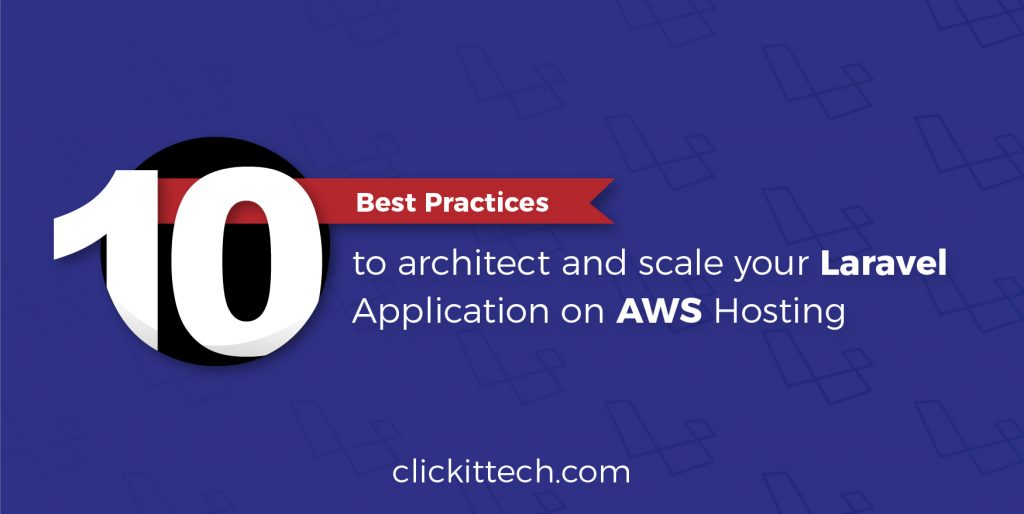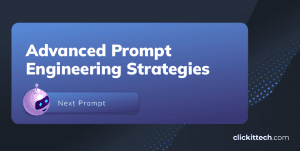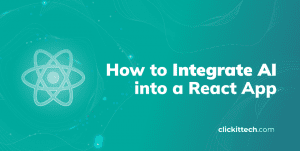This blog will give you valuable insights into the Laravel architecture best practices for modernizing and scaling your application using AWS. You will learn how to leverage AWS Auto Scaling and architecture to support millions of users in minutes, prepare your Laravel codebase for scaling transformations, and maximize AWS cost benefits. These features and capabilities can transform your application into a high-performance, resilient Laravel application.
This experience is a decision-maker article for Entrepreneurs, IT Leaders, and Business Development Managers. Whether you are kicking off an MVP app, deploying Laravel on AWS with basic principles and a Laravel event-driven architecture, or ready to jump from hundreds to millions of users, this article is for you and will help you scale the Laravel architecture diagram. So, let’s go!
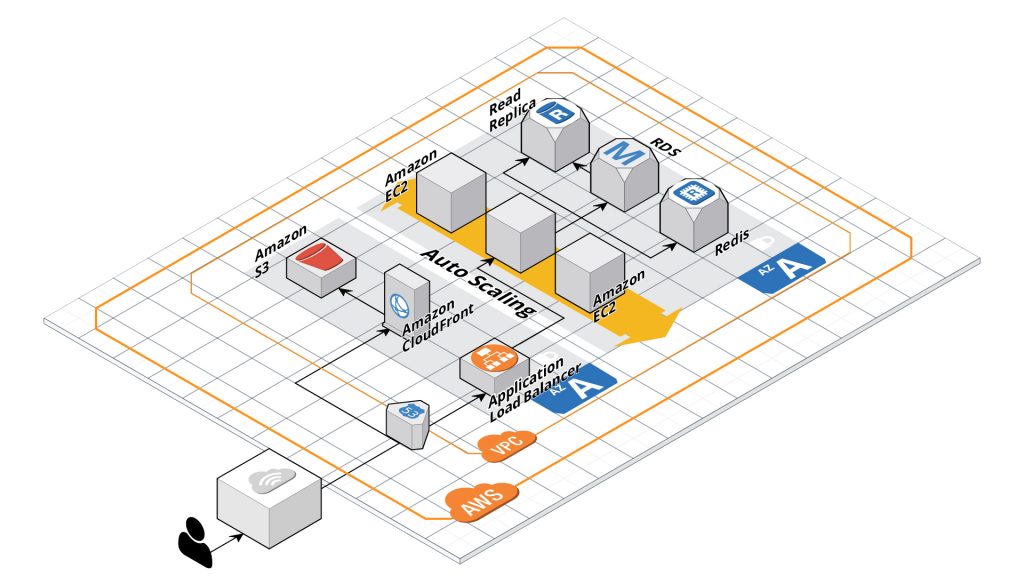
In the following Laravel architecture best practices, we will explore how a next-generation Laravel application should be architected with the full range of AWS DevOps components; each piece mentioned in this AWS stack is highly elastic, scalable, and resilient.
Practice 1. Amazon S3
Amazon S3 is the second component that boosted the evolution of the Cloud, just behind the pay-as-you-go model with cloud scalability. Amazon S3 is unlimited cloud storage with superb capabilities, including 99.99% durability and high availability, object-based storage acting as an API, and the ability to host static websites based on HTML, Angular, and React. Isn’t it amazing? Amazon S3 Cloud storage can be a serverless application without much effort.
The first best practice to scaling and architecting your Laravel application is to separate all static content (media, images, video, docs, etc.) to Amazon S3. This split allows the application’s requests to be distributed in parallel, with dynamic content served by the EC2 instance (Web Server) and the rest with Amazon S3. This is a DevOps and Development effort where all static content on your Laravel project is pointed to the Amazon S3 endpoint.
Technically, you need to move your actual content into Amazon S3 buckets, set the correct IAM roles/permissions to allow read access, and configure your Laravel driver to point to Amazon S3.
Check out this blog for more details on how to integrate Amazon S3 with Laravel.
Practice 2. Horizontal Scaling with AWS Auto Scaling (Load Balancer)
The next AWS component in the pipe is AWS Auto Scaling. This fantastic feature revolutionized the scalability paradigm. Before AWS Auto scaling, there was merely manual scaling, and reacting to different traffic events was difficult to converge and used to cause several failures.
AWS Autoscaling scales dynamically behind a load balancer (AWS Application Load Balancing), which is defined by a set of scaling policies (thresholds/limits) that must occur to scale up and down. The instances can scale up and down based on predefined criteria for CPU, RAM, or any other instance metric, allowing you to save money and unneeded AWS resources.
Primarily, to deploy AWS Auto scaling you need to:
- Set up AWS Application Load Balancing.
- Define a threshold for triggering the autoscaling event in AWS CloudWatch.
- Determine the Min/Max number of servers.
- Configure an AWS Auto Scaling Group.
- Set up AWS Auto Scaling launch configuration.
- Pre-configure the O.S with an Amazon Machine Image (AMI).
Practice 3. AWS RDS Aurora with Replication.
Amazon RDS is a database-managed service that requires minimal maintenance and is compatible with Mysql, PostgreSQL, Oracle, and more. The RDS is a self-maintained database with a pre-configured database, software updates, patches, and automated backups. To scale and cluster an Amazon RDS, first, you need to enable the RDS Replication feature, which grants your RDS the capacity to create replicas and establish master-slave relationships with those replicas, similar to Mysql/PostgreSQL replication; this can be achieved with just a few clicks.
Similarly, Amazon Aurora is a high-performance AWS database that combines high speed, high availability, and performance. According to AWS, Aurora is 5X faster than a standard MySql or 3X faster than PostgreSQL.
Amazon Aurora is a high-performance database from AWS. If you are planning to improve your database throughput, you should definitely consider Aurora.
Hint: AWS Aurora with replication and/or multi-AZ availability can be expensive. Take precautions with your cloud hosting budget. You can review this free AWS Cost Optimization Checklist to reduce your AWS billing.
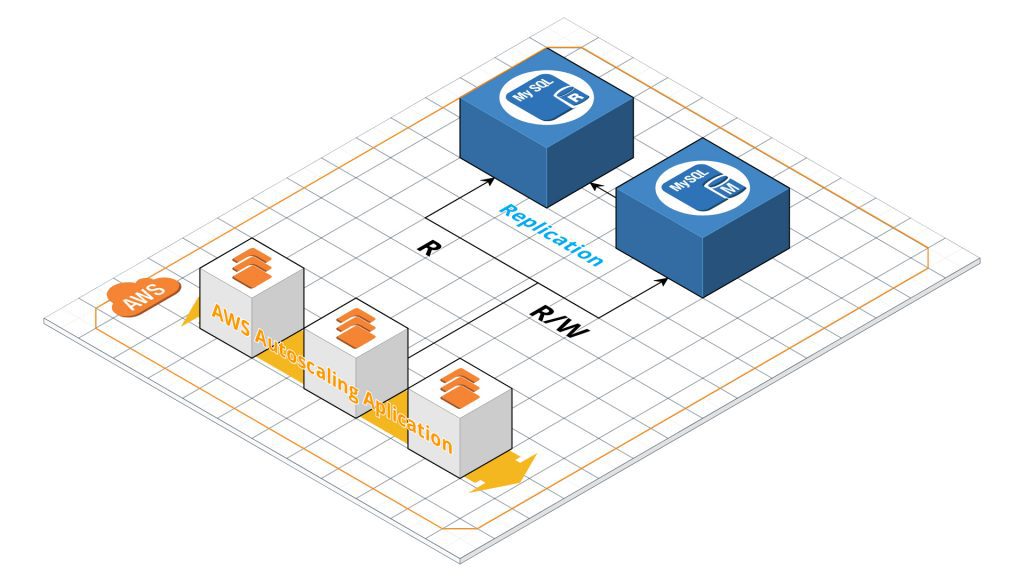
Practice 4. Application Load balancing – ALB (Laravel Load Balancer)
Another Laravel architecture best practice is introducing the application Load Balancing (ALB), a layer 7 LB. It has multiple benefits, including the capacity to balance requests by domain/URL and not just by port/protocol; it also supports the inclusion of multiple SSL certificates.
This service is also significantly cheaper than ordinary Load balancer service, and it’s billed by request; and one relevant fact about ALB is that you don’t need multiple Load balancers for integrating different APIs/Domains.
That said, I recommend architecting your Laravel architecture based on an ALB – Auto Scaling integration. It’s a must to have a load balancer enabled to scale and grow your SaaS Laravel application. You can balance your HTTP/https services, APIs, and any web socket. Lastly, the ALB was natively built for microservice environments with Docker, AWS ECS, and Kubernetes. Still, it can also be used with a monolithic approach, as presented in this architecture.
Practice 5. CloudFront CDN
Now that you have Amazon S3 running in your application, we must introduce CloudFront CDN in front of Amazon S3 and save Bandwidth for a clean architecture Laravel.
Amazon CloudFront CDN, is an amazing component with numerous features to highlight and commonly collaborates with Amazon S3. Amazon CloudFront is a Content Delivery Network aimed at caching content, distributing requests, serving video content, and many more features.
Some CloudFront capabilities:
- It helps improve application speed by caching static/dynamic content.
- It helps reduce AWS bandwidth costs from the Amazon S3 due to its caching magic.
- Similarly, it’s a video hosting solution for Media/Video streaming.
- It’s built to improve application performance and scalability by granting low latency.
- CloudFront can help secure your back-end instances and filter common botnets/DDoS attacks. An AWS WAF achieves this.
- It decreases the load on web instances, enabling fewer AWS resources.
It’s recommended to have an additional subdomain (C-Name Record) for this CloudFront edge location, i.e., cdn.company.com. Next, you need to create a CloudFront distribution where all content will be distributed across the edge locations; thus, the end user will start getting cached. And that’s it, considering you have your Laravel codebase pointing to Amazon S3. It should take you a few hours to set it up.
Practice 6: Amazon VPC Amazon Virtual Private Cloud and AWS Networking
Amazon VPC is a logical network on the AWS Cloud; it lets you build multiple isolated logical networks inside your infrastructure. Creating a VPC network and robust subnets is essential to growing, architecting, and structuring applications in multiple groups/departments.
AWS Networking (Amazon VPC) has various features, including subnet creation, route tables, own IP ranges, network ACLs, AWS security groups (Network firewall), network gateways, hardware Virtual Private Network (VPN) creation, and more.
When deploying a VPC for your SaaS Laravel application, you must ensure that web instances, databases, and backend services are all included on a private subnet, and in the other hand, the ALB is added on a public subnet. With this network topology, consider deploying a VPN to access your private network.
Your SaaS Laravel application can be transformed into a superbly secure logical network, complying with one of the multiple PCI/HIPAA/FedRamp requirements.
Practice 7. AWS ElastiCache (Redis and Memcached)
Introduce AWS Elasticache to scale Laravel application, to provide higher throughput and lower latency retrieved from your database.
AWS ElastiCache is a fully scalable, available, and managed caching and data storage system that aims to improve application performance, distributed cache data, and in-memory data structure stores. It’s an In-memory key/value store for Memcached and Redis engines, with a few clicks you can run this AWS component entirely self-managed.
The difficulty here is how to use AWS elastiCache with your application functionality and what application modules can be handled by your caching system. The integration from your Laravel architecture diagram to the AWS component is a 3 step-by-step process.
- Deploy AWS ElastiCache and identify your Redis end-point and port.
- Deploy predis/Redis package via Composer
- Connect your config/database.php file with your Redis end-point
Thus, it’s time to let the dev team figure out what pieces of your application can be used with AWS ElastiCache to improve high performance and throughput.
Practice 8. Route 53
Another best practice for your Laravel architecture diagram is to get the entire DNS domain controlled by Route 53. This AWS component can act as a DNS Load balancer, to Route traffic according to latency, and helps to scale modern cloud-native applications.
Amazon Route53, it is a modern DNS manager service designed to scale and improve high availability from the DNS perspective. Similarly, it has the ability to act as an API and can interoperate with your API Laravel application, it introduces as well the agility necessary to deploy scalable applications, and useful to integrate to Amazon EC2 instances, Elastic Load Balancing (ELB), and Amazon S3 buckets. I highly incentive, that modern Laravel SaaS applications should be migrated to Amazon Route 53, not just the application, also transfer your DNS records and domain name to Route 53.
Some Amazon Route53 features:
- Health Checks. Route53 can monitor your applications for outages or downtimes.
- DNS Failover Routing policy. You can obtain a failover solution on the DNS level, separating your SaaS PHP application into two environments: primary and backup.
- DNS Latency routing policy. This policy directs traffic requests to the lowest latency, between the end-user and the application environment. As a result, application speed and UX improvements.
- Geographic routing policy. This routing policy lets your requests be routed to the same physical region where you are located. Similar outcomes from the previous point degrade latency.
Practice 9. Scaling with Lambda
During these past 10 years in different periods, AWS has revolutionized the cloud vastly fast thanks to the Pay-as-you-go model, Auto scaling, DevOps, microservices and now Serverless (Lambda). In 2014, AWS lambda was released with the premise of running code without servers, introducing the paradigm of Serverless applications with minimal IT operations (NoOps), and jumping all SaaS ecosystems up to executing code per event only when needed.
Again, it is fully scalable, redundant, and has a pay-per-use pricing model. With Lambda, you are charged for the milliseconds consumed, the number of requests, and the compute. For more information, see the Lambda AWS official resource here.
Some Lambda use cases:
- Serverless web applications. Lambda can be handled to process the application logic of any front-end application (Angular, react and HTML). For instance, sending emails or processing forms requiring a Laravel backend process/job.
- Disaster Recovery and backups. Planning to script you backups inside an EC2 instance? Why don’t you move your bash scripts to a python Lambda function?
- Lambda and API Gateway. Lambda is commonly combined with AWS API Gateway, any logic that is required by your API Gateway is handled by lambda, for instance, to process persistent data to RDS or JSON calls coming from the AWS API Gateway.
- Process hot data. Lambda can transition data from Amazon S3 to Kinesis, DynamoDB or RDS.
- Scheduled events, workers, and jobs. Lambda can replace your cronjobs, workers and long-processing jobs that are hosted on a single EC2 instance as a cronjobs/workers.
- Build IoT and Mobile Backend. Develop your entire digital product (IoT and Mobile) with serverless and NoOps. It is composed of AWS Lambda, AWS API Gateway, and the mobile hub.

Web applications that can fit within this Laravel architecture best practices:
- API Laravel applications
- Mobile Backend applications
- Laravel enterprise applications. CRMs, ERPs, and back-office systems
- SaaS Laravel applications
- Front-end applications. i.e., Angular, React, Vue.js or any HTML site.
- ANY web platform: Python, Node.js, Ruby, PHP, Zend, CakePHP, Yii, and Symfony.

What have we learned about Laravel Architecture?
This blog explored how AWS can be the key to scale a Laravel application and the Laravel architecture best practices. By applying these measures to your web application, you are systematically converting a cloud-native application and joining the journey to the continuous digital transformation the AWS cloud is pulling us into.
You can find this article about Laravel Architecture Best Practices on DevOps.com here: Using Laravel and AWS: What You Need to Know and Best Practices for Your SaaS Laravel Application on AWS.

